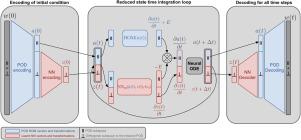Hybrid AutoEncoder/Galerkin approach for nonlinear reduced order modelling
IF 3
3区 工程技术
Q3 COMPUTER SCIENCE, INTERDISCIPLINARY APPLICATIONS
引用次数: 0
Abstract
This paper presents a novel nonlinear Reduced Order Model (ROM) that combines Proper Orthogonal Decomposition (POD) with deep learning residual error correction. Deep learning is used for error correction in both the projection and time integration phases of the ROM. This enables simultaneous correction within the POD subspace (error in the reduced subspace) and outside (truncation error). The present hybrid ROM is trained using an end-to-end neural Ordinary Differential Equations (ODE) framework, aligning the deep learning component with the continuous-time nature of the governing equations. We evaluate its performance using well-studied test cases: the viscous Burgers equation, the cylinder flow at a single Reynolds number (equal to 100), as well as for Reynolds numbers ranging from 60 to 120 (parametric cylinder case) and the fluidic pinball in the quasi-periodic regime. These non-chaotic test cases, are chosen to assess different aspects of the method and its ability to accurately predict reproducible dynamics. Our novel strategy outperforms several existing approaches both in terms of accuracy and dimensionality reduction: POD Galerkin ROMs, a purely data-driven approach using only autoencoders, and also state-of-the-art hybrid methods. Furthermore, it offers low computational overhead compared to classical POD-based ROMs, making it attractive for complex 2D or 3D systems.

非线性降阶建模的混合自编码器/伽辽金方法
提出了一种结合适当正交分解和深度学习残差校正的非线性降阶模型(ROM)。深度学习用于ROM的投影和时间积分阶段的误差校正。这可以同时校正POD子空间内(约简子空间中的误差)和外部(截断误差)。目前的混合ROM使用端到端神经常微分方程(ODE)框架进行训练,将深度学习组件与控制方程的连续时间性质对齐。我们使用经过充分研究的测试案例来评估其性能:粘性Burgers方程,单个雷诺数(等于100)的圆柱体流动,以及雷诺数范围从60到120(参数圆柱体)和准周期状态下的流体弹球。选择这些非混沌测试用例来评估方法的不同方面及其准确预测可重复动态的能力。我们的新策略在精度和降维方面都优于几种现有的方法:POD Galerkin rom,一种仅使用自动编码器的纯数据驱动方法,以及最先进的混合方法。此外,与传统的基于pod的rom相比,它提供了较低的计算开销,使其对复杂的2D或3D系统具有吸引力。
本文章由计算机程序翻译,如有差异,请以英文原文为准。
求助全文
约1分钟内获得全文
求助全文
来源期刊

Computers & Fluids
物理-计算机:跨学科应用
CiteScore
5.30
自引率
7.10%
发文量
242
审稿时长
10.8 months
期刊介绍:
Computers & Fluids is multidisciplinary. The term ''fluid'' is interpreted in the broadest sense. Hydro- and aerodynamics, high-speed and physical gas dynamics, turbulence and flow stability, multiphase flow, rheology, tribology and fluid-structure interaction are all of interest, provided that computer technique plays a significant role in the associated studies or design methodology.
 求助内容:
求助内容: 应助结果提醒方式:
应助结果提醒方式:


